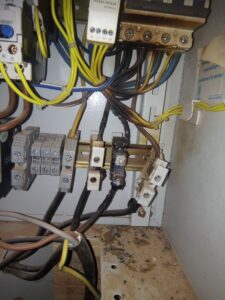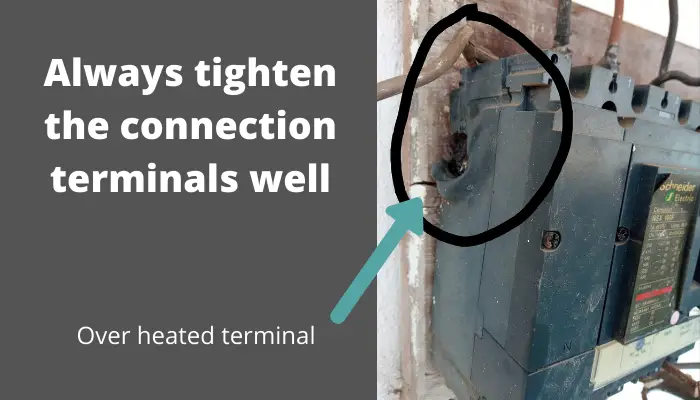Circuit breaker plays an important role in the safety of our daily life because it protects electrical equipment and devices against short circuits and overload faults.
The normal life of a standard circuit breaker is up to forty years. However, sometimes faults occur and a breaker goes bad.
Table of Contents
What does a bad breaker mean?
A bad breaker refers to a circuit breaker that is malfunctioning or failing to operate as it should. Circuit breakers are designed to trip (shut off) when they detect an overload, short circuit, or other electrical faults to protect the wiring and prevent fires. A bad breaker can fail in different ways:
Signs of a Bad Breaker:
- Frequent Tripping – If a breaker trips too often, even under normal loads, it may be faulty.
- Doesn’t Reset – If you try to reset it, but it won’t stay in the “ON” position, the breaker may be damaged.
- Overheating – A breaker that feels hot to the touch can be defective or overloaded.
- Burn Marks or Smell – Signs of burning or a melted plastic smell near the breaker panel indicate a serious issue.
- Loose or Wobbly Breaker – A breaker that moves or doesn’t sit firmly in place might have a poor connection.
- Inconsistent Power – If lights flicker or some outlets don’t work consistently on the same circuit, the breaker might be failing internally.
What Should You Do?
- Check for Overload – Ensure you’re not overloading the circuit before assuming the breaker is bad.
- Test the Breaker – A qualified electrician can test it with a multimeter.
- Replace It – If the breaker is bad, it needs to be replaced with the same type and rating.
A bad breaker is a serious issue because it can lead to electrical fires or power failures. If you suspect one, it’s best to get it checked and replaced if needed.
I’ve written a detailed article about circuit breaker tripping, you can read it here for more information.
What to Do When a Circuit Breaker Trips?
A circuit breaker tripping is a safety feature that protects your home’s electrical system from overloads or short circuits, which could lead to fires or other hazards.
- Find the Cause – Check which appliance or device may have caused the overload or short circuit. Unplug or turn it off before resetting the breaker.
- Reset the Breaker – Switch the tripped breaker off and then back on to restore power.
- Watch for Issues – If the breaker stays on, the problem is likely resolved. If it trips again, there may be a bigger issue.
- Call an Electrician – If the breaker keeps tripping or shows signs of damage, have a professional inspect it. They can determine if it needs to be replaced or if there’s another electrical problem.
Most of the time, simply resetting the breaker is enough. But if it trips repeatedly, it’s best to get it checked to keep your electrical system safe.
For more information read my article, Breaker Keeps Tripping?
What to Do If Your Circuit Breaker Is Stuck in the Middle?
A circuit breaker has three positions: ON, OFF, and a middle position that indicates a trip. If your breaker is stuck in the middle, it means something triggered it, but it hasn’t fully switched to “OFF.”
Possible Reasons:
- Electrical Overload – Too many devices on one circuit caused it to trip.
- Short Circuit – A fault in the wiring or an appliance triggered the breaker.
- Mechanical Issue – The breaker itself may be faulty or worn out.
How to Fix It:
- Find the Cause – Check for overloaded circuits or faulty appliances.
- Turn It Off – Push the breaker firmly to the “OFF” position. Avoid using excessive force.
- Investigate Further – Once off, unplug devices and check for potential issues.
- Call an Electrician – If the breaker won’t reset or you’re unsure of the cause, get a professional to inspect it.
Safety First! If you’re unsure, it’s best to call an expert to avoid electrical hazards.
For more about short circuits, read my detailed article here.

Signs of bad breakers you can recognize without a multi-meter!
While a multi-meter is a valuable tool for diagnosing electrical issues, there are some signs of bad breakers that you can recognize without using one. Here are some common signs that may indicate a faulty circuit breaker:
-
Frequent Tripping: If the breaker frequently trips, especially when it shouldn’t be under excessive load, it could indicate a problem.
-
Burning Smell: A burning smell coming from the breaker panel or anywhere near electrical outlets could suggest an electrical issue, potentially caused by a faulty breaker.
-
Visible Damage: Look for any visible signs of damage, such as frayed wires, burn marks, or discoloration around the circuit breaker.
-
Buzzing Sounds: If you hear unusual buzzing or humming sounds coming from the breaker panel, it could indicate loose connections or faulty components.
-
Hot Breaker Panel: A breaker panel that feels excessively hot to the touch might indicate an overloaded circuit or a malfunctioning breaker.
-
Flickering Lights: If lights flicker or dim without any apparent reason, it could indicate an issue with the electrical supply, potentially caused by a bad breaker.
-
Tripped Breaker Won’t Reset: If a tripped breaker refuses to reset or stays in the tripped position, it is likely malfunctioning and may need to be replaced.
If you notice any of these signs, it is essential to address the issue promptly to prevent potential electrical hazards.
Contact a licensed electrician for a professional assessment and resolution of the problem. Avoid attempting any repairs or replacements without proper knowledge and training, as it can be hazardous. Always prioritize safety when dealing with electrical issues in your home or building.
What causes a circuit breaker to go bad?
There are three main reasons for a bad CB. It is either due to:
-
Overloading: Excessive electrical loads on a circuit can cause the breaker to trip frequently, leading to wear and tear on its internal components. Continuous overloading can eventually lead to the breaker going bad. I have written a detailed article about OverCurrent you can check it out for more information.
-
Age: Like most electrical components, circuit breakers have a limited lifespan. With age, the internal components may deteriorate, leading to malfunctions or complete failure.
-
Environmental Factors: Harsh environmental conditions such as high humidity, extreme temperatures, or exposure to chemicals can contribute to the degradation of the circuit breaker’s components over time.
-
Manufacturing Defects: In some cases, a circuit breaker may have inherent defects from the manufacturing process, leading to early failure or malfunction.
-
Frequent Power Surges: Repeated power surges, either from the utility provider or internal electrical devices, can strain the circuit breaker, causing it to wear out over time.
-
Physical Damage: Physical damage to the circuit breaker, such as from accidents, improper handling, or exposure to water, can compromise its functionality and lead to failure.
-
Poor Maintenance: Lack of proper maintenance, such as neglecting to address electrical issues promptly or not conducting regular inspections, can lead to the deterioration of the circuit breaker.
- Loosen-connected wiring: Loose wiring connections can also contribute to circuit breaker issues and lead to various problems within an electrical system. When wiring connections are not properly secured, several issues can arise.
If you suspect a problem with your circuit breaker, it is advisable to consult a qualified electrician for a professional assessment and any necessary repairs or replacements.

Can you fix a bad circuit breaker and reuse it?
In most cases, a bad circuit breaker should be replaced rather than repaired. While some minor issues, like a loose connection, can be fixed, a faulty breaker is often a safety hazard and not worth reusing.
Why Replacing is Better Than Fixing:
- Breakers Wear Out Over Time – Internal components degrade, making them unreliable.
- Safety Risk – A faulty breaker may not trip properly, increasing the risk of electrical fires.
- Manufacturers Don’t Recommend Repairs – Breakers are designed as sealed units, not meant to be opened or repaired.
When Can a Breaker Be Fixed?
- Loose Connections – If the breaker isn’t seated properly in the panel, tightening the connection might solve the issue.
- Dust or Debris – If dirt is causing a poor connection, cleaning around the breaker (with power off) may help.
- Tripped but Not Reset Properly – Sometimes, switching the breaker fully OFF and then ON fixes the problem.
When to Replace It:
- If the breaker feels hot or has burn marks
- If it trips frequently without an overload
- If it won’t reset or stays in the middle position
- If it smells burnt or makes a buzzing sound
Bottom Line: If your breaker is bad, it’s best to replace it with a new one of the same type and rating. A licensed electrician can ensure it’s done safely.
Don’t Leave Empty-Handed!
Install my Free Android App on Google Play:
Electrical Cables Most Common Tables “Cables Tables”
And, my Electrical Calculations App “Fast Electrical Calculator”
Discover more great content by subscribing to My channel
Looking to stay ahead of the game in the world of electrical engineering? Subscribe to my YouTube channel and gain access to exclusive content you won’t find anywhere else!
The staff I recommend
(Amazon Affiliate Links to products I believe are high quality):
- Economy 120 Volt/60Hz AC Power Source – Step-Down Voltage & Frequency Converters 1800W
- UNI-T Digital Multimeter Tester UT139C
- 50-Amp Extension Cord for RV “100ft”
- Voltage Stabilizer 110/220v
- Hair Dryer “best selling“
- TOSHIBA EM131A5C-BS Countertop Microwave Ovens
Disclaimer: This contains affiliate links to Amazon products. I may earn a commission for purchases made through these links.

